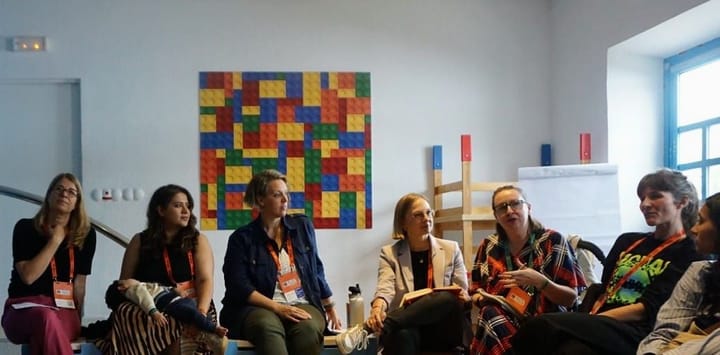Rise Against Big Tech: A Movement For Collective Digital Freedom
Breaking Big Tech’s grip means more than new tools, it’s a cultural shift toward collective infrastructure, shared values, and digital autonomy says Dirk Slater.

By Dirk Slater, FabRiders with input from the RABT Coalition
Across social justice and digital rights movements, urgency is growing: Big Tech platforms have come to shape nearly every aspect of our digital lives, often through surveillance, exploitation, and monopolistic control that deepens divides, erodes trust and isolates communities. Breaking that dependence is not simply about switching software; it is a cultural and strategic shift that demands shared values, collective action, and long-term planning. Our recent Rise Against Big Tech (RABT) workshop, organized by the RABT Coalition as part of InfraRed, explored why this shift matters and revealed both what’s broken and what’s possible if communities work together with collective values, strategic intent, and practical tools. The workshop surfaced a shared challenge: understanding not just why we must move away from Big Tech, but how to do it in ways that strengthen mission, culture, and collaboration:
Migrating Away from Big Tech: How to Approach It
Mission Alignment:
A migration plan needs to begin by asking: Does this serve our organization's strategy, values, and mission? Every group at the workshop discussed how critical it was to anchor technology transitions in long-term goals for impact and justice, never as a reaction to temporary frustration.
Migration should become an opportunity to deepen organizational culture, strengthen autonomy, and foster creativity. When guided by mission, strategy, and collective ownership, groups can clarify trade-offs during transition, build widespread commitment, and allocate resources, ensuring that training and onboarding support everyone in making the shift.
For many groups, especially those based in the United States, this decision carries an added sense of urgency. Under heightened government surveillance and increasing partnerships between state agencies and private tech firms like Palantir and Babel Street, organizations involved in activism, migration, or human rights work face tangible risks when using mainstream platforms. Moving to privacy-respecting and independent technologies is not only about aligning with organizational values—it has become a necessary step for self-protection and safeguarding the people and communities these groups serve.
Collective Transition:
Big Tech isolates users by making convenience personal and addictive. Moving your bookmarks, contacts, shared folders, and years of random Google Docs is frustrating. But escaping big tech’s grip requires collective action—both within and between organizations. It’s not enough for one team or one organization to switch tools; meaningful change demands coordination across networks, coalitions, and partnerships so the groups we collaborate with can transition together. Migrating away from tools like Zoom, Google Docs, or WhatsApp means reimagining the digital spaces where our movements communicate, organize, and share knowledge. Building shared agreements, accessible alternatives, and common practices across organizations transforms migration from a logistical challenge into a movement-wide act of solidarity and digital autonomy.
Cultural Change:
Conversations about migration often start with the practical: which tools to use, what to replace, what will break. But real change begins with a shared understanding of why this matters. Big Tech’s dominance has reshaped how we communicate, collaborate, and even think about community, often in ways that reward surveillance, control, and convenience over care. Talking openly about these dynamics helps colleagues connect the technical to the ethical and turns frustration into shared purpose.
Barriers to exiting Big Tech abound, including onboarding, workflow changes, data migration headaches, and usability gaps in alternatives. Older users, those with limited technical proficiency, and entire networks may require additional support. However, the long-term benefits are substantial—encompassing better privacy, genuine control, and community-driven growth. When organizations treat technology as part of their broader mission, rather than as a background utility, they can use each transition to strengthen collaboration, autonomy, and collective resilience.
To aid this transition, organizers of the RABT workshop introduced participants to a curriculum designed by FabRiders to help organizations start their own conversations about moving away from Big Tech. This resource provides a step-by-step guide that organizations can use to bring the conversation home: building buy-in, understanding, and common cause for mission-driven migration.
The RABT Workshop as a Case Study
The workshop drew around 130 people from diverse backgrounds, geographies and organizations. Using Jitsi Meet for conferencing and Etherpads for collaborative note-taking, participants ensured transparent documentation and collective ownership of ideas and decisions, modeling some of the principles I touched on earlier. The hope for us, as organizers, was to set a strong example: moving away from Big Tech requires not just swapping out tools, but building new habits and cultures where everyone participates.
From Curiosity to Entrapment
We started the workshop by asking participants to reflect on their initial experiences with computers. Those stories centered on hope, curiosity, and the creative promise of technology. Over time, participants said their optimism had turned into apprehension. They mapped how platforms they had once helped them connect and create now function to surveil, control, and isolate individuals. Big Tech thrives by drawing each of us in individually, designing addictive features and seamless experiences that make alternatives feel daunting or risky. Unlearning these patterns, participants noted, is as much about changing culture as it is about switching software and platform providers.
Intersectionality, Surprises, and Hope
Participants found the collection of stories surprisingly intersectional—connecting tech liberation with climate, health, anti-imperialism, and democracy. This workshop reaffirmed that the most resilient momentum is collective: strategic engagement and shared ownership carry organizations through daunting challenges.
Conclusion: Building Collective Infrastructure for Movement Technology
The RABT movement runs on infrastructure designed for collectivity and mission-alignment, building on the scaffolding that allows organizations to learn from each other, share resources and communicate at scale. Its focus is not only on replacing Big Tech tools but on:
- Decision frameworks: to help organizations evaluate tools against their mission, strategy and values, ensuring that technical choices reinforce collective purpose.
- Practical guides and resources: riseagainstbig.tech offers migration resources, ethical decision-making tools, and tailored "harm reduction" approaches if full divestment isn't yet practical.
- Peer learning and support: through dedicated onboarding and networked experimentation, helping organizations share lessions, troubleshoot challenges, and build capacity together.
- Community channels: connect with members across movements and access shared learning spaces.
Migrating away from Big Tech is neither quick nor easy. However, with a collective strategy, dedicated resources, and curriculum-backed conversations, each transition becomes a tool for deepening values, empowering communities, and advancing organizational goals. Resilience grows not from technical decisions, but from how those decisions serve the broader mission and ability to execute a strategic plan.
Join the movement:
For resources and support for your organization, visit https://riseagainstbig.tech, then join the movement to make technology a tool for liberation and justice, not private profit:
- Subscribe to RABT listserve to engage and ask questions.
- Join the RABT mailing list to receive our low volume newsletter and events invitations.
- Explore resources and practical guides at riseagainstbig.tech,
SplinterCon:Paris
SplinterCon brings together technologists, researchers, and policymakers to explore what resilient, interconnected digital societies require in an era of growing fragmentation. Each gathering bridges technical and policy perspectives, linking innovation in decentralized infrastructure with critical conversations about governance, sovereignty, and human rights.
Through its two core themes, Technology and Innovation and Policy and Governance, SplinterCon Paris, in partnership with the National Centre for Scientific Research, will examine how decentralized systems, censorship-resistant communications, and evolving models of digital sovereignty can strengthen rather than divide the global internet.
📅 8–10 December 2025
📍 Paris, France
Support the Internet Exchange
If you find our emails useful, consider becoming a paid subscriber! You'll get access to our members-only Signal community where we share ideas, discuss upcoming topics, and exchange links. Paid subscribers can also leave comments on posts and enjoy a warm, fuzzy feeling.
Not ready for a long-term commitment? You can always leave us a tip.
This Week's Links
UN Cybercrime Treaty Signing
- At the UN Cybercrime Treaty signing in Hanoi, governments (minus Canada, New Zealand, the United States, and a few other key signatories) celebrated a new era of global cooperation against cybercrime, but the event exposed how deeply state power still dominates internet governance, with civil society and digital rights defenders largely excluded from shaping the treaty. https://www.techpolicy.press/dispatch-from-hanoi-un-cybercrime-treaty-signing-exposes-a-highly-statecentric-process
- A coalition of 19 digital rights and civil society organizations, including Access Now, ARTICLE 19, Human Rights Watch, and the Electronic Frontier Foundation, issued a joint statement urging states not to sign the UN Cybercrime Convention, warning it will enable cross-border human rights abuses. https://www.hrw.org/news/2025/10/24/joint-statement-on-the-signing-of-the-un-convention-on-cybercrime
- The United States declined to sign the new UN cybercrime treaty, as digital rights groups warned its language could enable surveillance and repression by authoritarian governments. https://subscriber.politicopro.com/article/2025/10/us-signature-absent-from-controversial-un-cybercrime-treaty-00624229
- Vietnam’s longstanding record of cracking down on online dissent makes it a fitting host for the signing ceremony of the deeply flawed United Nations Convention against Cybercrime. https://thediplomat.com/2025/10/un-treaty-signing-highlights-vietnams-curb-on-online-dissent
Internet Governance
- The UN is seeking input for a report on how digital and AI-powered surveillance is undermining freedom of assembly and association worldwide. https://www.ohchr.org/en/calls-for-input/2025/call-input-hrc62-thematic-report-impact-digital-and-ai-assisted-surveillance
- The EU Cyber Resilience Act is coming into force. Thanks to an unprecedented effort by multiple organisations, for the first time ever, draft standards will be made public so that developers, in particular from the Open Source community, can comment on them in Gitlab. https://labs.etsi.org/rep/stan4cra
- A new report outlines how an EU Sovereign Tech Fund could strengthen Europe’s digital sovereignty and cybersecurity through support for open source infrastructure. https://eu-stf.openforumeurope.org
- A Dispatch article argues that the Open Technology Fund, which supports projects like Signal and the Tor Project, is vital for helping people under authoritarian regimes access a free and secure internet. https://thedispatch.com/article/open-technology-internet-china-iran
- Laura Galante and Tal Feldman argue that the US is falling behind China in writing the technical standards that shape global infrastructure and AI systems, urging Washington to treat standards-setting as a strategic tool of statecraft. https://www.lawfaremedia.org/article/technical-standards--america-s-forgotten-tool-of-statecraft
- The Shorenstein Center at Harvard Kennedy School is launching a new initiative on independent media in 2026, led by journalist Julia Angwin, to study how emerging platforms shape public discourse and democracy. https://shorensteincenter.org/article/independent-media-julia-angwin
- Civil society groups have condemned Ireland’s appointment of former Meta lobbyist Niamh Sweeney as a new data protection commissioner, warning it undermines the independence of the Irish Data Protection Commission and violates EU rules on impartiality. https://euobserver.com/digital/ar6c78a452
- A new report from Columbia World Projects and the Centre for Digital Governance at the Hertie School lays out practical recommendations to build data-access, analysis and accountability infrastructure for platform research, thereby strengthening democratic resilience. https://worldprojects.columbia.edu/sites/default/files/2025-10/building-capacity-report.pdf
Digital Rights
- The Coalition for Independent Technology Research has released The State of Independent Technology Research 2025, a report warning that funding cuts, data access barriers, and safety threats are undermining public-interest research essential for holding tech power to account. https://independenttechresearch.org/citr-report-2025
Technology for Society
- Twenty emerging leaders (including IX’s Mallory Knodel!) have been selected for the Public Voices Fellowship on Technology in the Public Interest, an OpEd Project and MacArthur initiative helping experts shape public narratives around technology and society. https://www.macfound.org/press/grantee-news/new-voices-shaping-narrative-of-technology-for-the-public-interest
- Signal’s president Meredith Whittaker explains that the app’s reliance on AWS reflects a deeper problem: the vast concentration of global infrastructure power among a few tech giants, leaving few real alternatives. She concludes that her silver lining hope is that “AWS going down can be a learning moment, in which the risks of concentrating the nervous system of our world in the hands of a few players become very clear. And that this can help us craft ways of undoing this concentration and creating real choice. https://mastodon.world/@Mer__edith
- Elon Musk, a frequent critic of Wikipedia, has launched Grokipedia, an AI-run encyclopedia that he says reflects his rightwing views. It claims to be “fact-checked” by his chatbot Grok and has no human editors. https://www.theguardian.com/technology/2025/oct/28/elon-musk-grokipedia
- AI in the MENA region is deepening inequalities and reshaping civic space, labor, and gender dynamics, with growing feminist and regional pushback. https://policy-practice.oxfam.org/resources/artificial-intelligence-and-social-and-gender-justice-activism-in-mena-spaces-o-621738
- AIMLab has released its community-based Algorithmic Impact Assessment toolkit, sharing methods, pilot documentation, and field notes that highlight how centering impacted communities can reveal flaws and improve AI governance. https://datasociety.net/research/algorithmic-impact-methods-lab/?tab=Get%20The%20Toolkit
- Character.AI will bar users under 18 from chatting with its AI companions after lawsuits alleged the platform contributed to teen suicides, marking one of the industry’s strongest child-safety moves yet. https://www.nytimes.com/2025/10/29/technology/characterai-underage-users.html
Privacy and Security
- Watch IX’s Mallory Knodel moderate the panel Spies, Cops, and Cyber Cops Defending Encryption. In it, speakers share their perspectives on how encryption has supported their work, and how anti-encryption policy proposals could compromise crime-fighting and security in the future. https://www.youtube.com/watch?v=1cj2MbsTzc0
- A Forbes report reveals that ICE uses WhatsApp metadata and private surveillance tools to track suspects, despite Whatsapp’s encrypted messages. https://www.forbes.com/sites/the-wiretap/2025/10/21/ice-spies-on-whatsapp
- The Safety Net Project outlines how encryption can help survivors of gender-based violence and service providers protect sensitive data and communications, while emphasizing it is only one part of a broader security strategy. https://www.techsafety.org/encryption-basics-for-programs
- Tinder will soon require new US users to complete a facial video scan before using the app, aiming to cut down on bots, duplicate accounts, and impersonation, says Yoel Roth, formerly head of Trust and Safety at Twitter. https://www.wsj.com/tech/tinder-bets-on-safety-improvements-to-build-trust-and-long-term-growth-6d4ccd6f
Upcoming Events
- AIDP Hosts Eldrid Jordaan in Washington DC and Online - "The Silicon Empire v. Social Impact: The David and Goliath Battle.” November 3, 3pm EDT. Washington DC: https://docs.google.com/forms/d/e/1FAIpQLSefA01nhNk2aGuIUdvgj_-CuP-I5Dq2hg5fgmppdB3rx0R6tw/viewform and Online: https://us02web.zoom.us/meeting/register/bk--scjJThGX3XgOT6p3Og#/registration
- Digital Governance for Democratic Renewal: Nathan Schneider on the Primacy of Attention. November 5, 3pm GMT. Online. https://columbiauniversity.zoom.us/webinar/register/WN_DZfEoh2lTva7c5kdALiYzQ#/registration
- A full-day conference at the University of Colorado Boulder will explore how generative AI is reshaping the politics of copyright, from fair use battles to the future of creative rights and policymaking in Washington. November 7, 9am MT. Bolder, CO and Online. https://siliconflatirons.org/events/ai-and-the-future-of-copyright-politics_2025-11-07
- Advocating with Evidence: Lessons for Tech Researchers in Civil Society. November 13, 10am ET. Online. https://cdt.org/event/advocating-with-evidence-lessons-for-tech-researchers-in-civil-society
Careers and Funding Opportunities
- Scale: Machine Learning Research Lead, Security & Policy Research Lab. San Francisco, CA. https://scale.com/careers/4620629005
- Common Sense Media: AI Risk Assessment Fellow. San Francisco, CA. https://www.linkedin.com/jobs/view/4275244207
- Google:
- Red Teaming Lead, Responsibility. Mountain View, CA. https://job-boards.greenhouse.io/deepmind/jobs/7336899
- AI Ethics and Safety Policy Researcher. Mountain View, CA. Apply by November 7. https://job-boards.greenhouse.io/deepmind/jobs/7349530
- Research Scientist, Frontier AI Safety and Responsibility. New York, NY. Apply by October 31. https://job-boards.greenhouse.io/deepmind/jobs/7341608
- Salesforce: Data Scientist/Sr. Data Scientist - Technical AI Ethicist. Multiple Locations in CA and WA. https://careers.salesforce.com/en/jobs/jr291587/data-scientistsr-data-scientist-technical-ai-ethicist
- MacArthur Foundation: Director, AI Opportunity. Chicago, IL. https://macfound.wd1.myworkdayjobs.com/en-US/MAC_FOUND_EXT_CAREERS/job/Chicago-Office/Director--AI-Opportunity_REQ-000315
- Harvard University: Senior Data and Network Scientist. Boston, MA. https://careers.harvard.edu/job/senior-data-and-network-scientist-in-cambridge-ma-united-states-jid-531
- Schmidt Sciences: AI Institute Fellow in Residence. New York, NY. https://jobs.lever.co/schmidt-entities/c42b4c52-d92a-4bd6-bac6-6b2d94159b35
- Department of Commerce: Chief Artificial Intelligence Officer. Alexandria, VA. Apply by November 27. https://www.usajobs.gov/job/848882700
- University of Virginia: Digital Technology for Democracy Postdoctoral Research Fellow. Charlottesville, VA. https://jobs.virginia.edu/us/en/job/R0077062/Digital-Technology-for-Democracy-Postdoctoral-Research-Fellow
- Gates Foundation: Senior Advisor, AI Strategy & Ecosystem Partnerships. Seattle, WA. https://gatesfoundation.wd1.myworkdayjobs.com/en-US/Gates/job/Senior-Advisor--AI-Strategy—Ecosystem-Partnerships_B021253
- Microsoft:
- Senior Strategist of Public Policy, Office of Responsible AI. Redmond, WA. https://jobs.careers.microsoft.com/global/en/job/1897659/Senior-Strategist-of-Public-Policy%2c-Office-of-Responsible-AI
- Senior Research Scientist (ML, AI for Good Lab - Social Impact). Redmond, WA. https://www.linkedin.com/jobs/view/senior-research-scientist-ml-ai-for-good-lab-social-impact-at-microsoft-4332861794
- Protect Democracy. Remote US:
- Full-Stack Engineer (Contract) https://protectdemocracy.recruitee.com/o/full-stack-engineer-contract
- Data Engineer (Contract) https://protectdemocracy.recruitee.com/o/data-engineer-contract
- Brookings: Spring 2026, Research and Events Internship, AI and Emerging Technology, Executive Office. Multiple Remote Locations US. https://interns-brookings.icims.com/jobs/3746/spring-2026%2c-research-and-events-internship%2c-ai-and-emerging-technology%2c-executive-office-%28job-id-2025-3746%29/job
- Omidyar Network: Reporters in Residence (Winter 2026). Remote US. https://job-boards.greenhouse.io/omidyarnetwork/jobs/7329668
Global
- University of Technology Sydney: Responsible Technology Policy Specialist. Sydney, AU. https://www.linkedin.com/jobs/view/4314708373
- BMO: Senior Data Scientist, Responsible AI. Toronto, CA. https://bmo.wd3.myworkdayjobs.com/external/job/Toronto-ON-CAN/Senior-Data-Scientist--Responsible-AI_R250026261
- Ada Lovelace Institute: Associate Director, Emerging Technology & Industry Practice. London, UK. https://micro.green-park.co.uk/adalovelace/assistant-director-emerging-technology-industry-practice
- Associate Director, Emerging Technology & Industry Practice.
- Bluesky: Policy Lead, Trust & Safety. Remote. https://jobs.gem.com/bluesky/am9icG9zdDpprddgG4dmaiRaM_tlj2rM
- Internet Society: Product Manager, Internet Measurements. Remote. https://internetsociety.bamboohr.com/careers/304
What did we miss? Please send us a reply or write to editor@exchangepoint.tech.




Comments ()